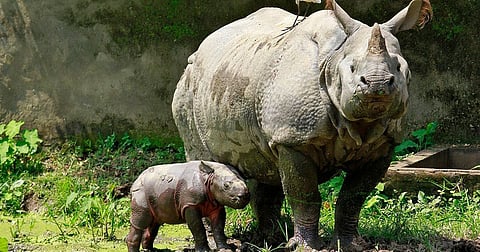
- Home
- Live Blog
- Breaking News
- Top Headlines
- Cities
- NE News
- Sentinel Media
- Sports
- Education
- Jobs

The submergence of Kaziranga National Park during annual floods presents a plethora of conservation challenges to the park authorities.
Ensuring the safety of park animals fleeing flooded grassland towards the highlands of Kaziranga-Karbi Anglong landscape for food and shelter from roadkill is always high on the list of priorities. To date, 167 of the 223 forest camps on the World Heritage Site have been inundated by the current wave of flooding. This has made regular anti-poaching activities more challenging. The introduction of the piloting of light vehicles in a convoy has replaced the system of timecards and is found to be more effective in regulating the movement of vehicles along the National Highway 715 passing through the park. In the earlier system of timecards, some erring drivers were found to be speeding beyond the limit while passing through animal corridors, resulting in the roadkill of migrating animals along the highway. Chief Minister Himanta Biswa Sarma instructing the deployment of additional National Disaster Response Force battalions to augment ongoing relief operations and additional mobile veterinary clinics to assist stray wild animals after an assessment of flood preparedness at the National Park is a timely intervention for better management of the disaster situation. Restricting the movement of commercial vehicles through the park areas has facilitated better management of passenger vehicles. The whole government approach to dealing with the prevailing flood situation is a pragmatic move to lessen the burden on the park authorities, ensure the right of passage for the park animals, and step up vigil against any attempt at poaching taking advantage of the situation. The issue of the safety of migrating animals is a grim reminder for expediting the construction of the proposed elevated corridor in the park for permanent measures for safer animal crossings during flood as well as non-flood periods. Once the corridor is constructed, and the existing highway is decommissioned, the animals fleeing the flooded areas will migrate to the higher lands of Karbi Anglong and return to grasslands after the water level recedes. Rescue of park animals, more particularly animal claves marooned or getting lost on their way to safety, must remain another priority to reduce casualties and save the flood-hit animals. The Centre for Wildlife Rehabilitation and Conservation (CWRC) has been extending outstanding service in providing treatment and care to rescued animals and successful rehabilitation. Kaziranga being an iconic conservation and tourism site, more government and non-government support from global organisations supporting conservation work at the CWRC and similar organisations is critical to sustaining the conservation initiatives. Roping in village defence parties and National Service Scheme volunteers for night patrolling and rescue operations as flood volunteers underlines the crucial role played by fringe villages in conservation of the park ecosystem during disaster situations. Annual flooding of Kaziranga grasslands also has multiple benefits that are essential to assessing the impact of overall flood submergence. Kaziranga sustains a gene pool of fish and other aquatic stocks, and floods help replenish the wetlands along the Brahmaputra with stocks of indigenous fish and other aquatic species vital for the conservation of the ecological services of these wetlands. Floodwaters also flush out water hyacinth and other invasive weeds from the grasslands to preserve their ecological character. Given the spread of park areas, this role of nature is not possible to replace with human intervention. Overgrowth of water hyacinth and unwanted weeds pose conservation threats to park animals and result in a shortage of fodder in the grassland and a reduction of oxygen levels in the waterbodies of the park. The Forest Department of Karbi Anglong Autonomous Council also plays the most crucial role in ensuring the safety of park animals taking shelter on the highlands of the Karbi Anglong landscape during the entire flood season. Participation of village defence parties from fringe villages bordering the park areas bolsters disaster management as it also ensures the conservation role of villagers. Karbi villages have preserved their heritage and traditions of co-existence with nature and wildlife, which have many lessons in wildlife conservation to learn. They have a high reverence for nature and wildlife, which makes their participation in conservation initiatives much easier for forest departments, council authorities, and NGOs working for nature and wildlife conservation. Annual flooding of Kaziranga park areas also puts the spotlight on the role traditionally played by Karbi people living on the hills in conservation of the entire Kaziranga-Karbi Anglong landscape and sustaining the animal population of the park by ensuring their food and shelter in natural ecosystems. The Forest Department of the Karbi Anglong Autonomous Council, NGOs working for conservation in the Karbi Hills, and getting adequate resources to strengthen these conservation initiatives and conservation of the ecology are critical to the overall conservation of the Kaziranga-Karbi Anglong landscape. The coordinated action by the council authorities and the state government is essential for better management of the flood situation in the national park.